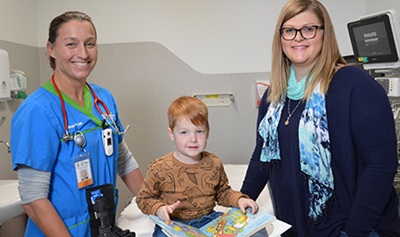Breaking new ground for leg fractures in toddlers

Dr Kate Bradman (PCH ED Consultant) holding a CAM Boot, Leo and Jodie Bowles
New research published in the Emergency Medicine Journal has found benefits in using a Controlled Ankle Motion (CAM) walking boot to treat a toddler’s fracture compared to the use of more ‘cumbersome’ full leg plasters.
Lead researcher and Paediatric Emergency consultant Dr Kate Bradman said the study has resulted in a new practice at PCH which is making life far easier for parents managing this injury.
All children aged between 1to 5 years who present to the ED with a toddler’s fracture, a twisting injury which causes the child to stop weight bearing are now treated with the CAM boot instead of the full leg plaster.
“The CAM boots are far easier for both parents and toddlers to manage particularly with negotiating car seats and highchairs and they can be adjusted and removed for bathing, dressing and toileting,” Dr Bradman said.
Dr Bradman said witnessing friends and patients manage the difficulties of a young child in a leg plaster prompted her to question whether an injury would heal just as effectively if it was immobilised in a below knee walking boot instead of a plaster.
More than 80 parents participated in the trial which tracked fracture healing, pain and interaction with daily activities when the fracture was treated with a plaster cast instead of a CAM boot.
Jodie Bowles was one of the trial participants who managed a plaster cast for her one-year-old son Leo following an accident. Leo’s plaster was recast on seven occasions within a month due to breaks in the plaster.
"I’m delighted we participated in this study which has had an amazing outcome.
“It’s fantastic to know other toddlers with a similar fracture to Leo’s no longer have to endure the pain and stress of plaster," said Ms Bowles.
Dr Bradman is delighted with the outcome of her study which is benefiting parents and toddlers with this type of injury due to the change in practice in the PCH ED.
“I had never been interested in leading my own research project until I commenced work at PCH but I was inspired by the prospect of creating positive change through this project,” said Dr Bradman.
The study was run in partnership with the Orthopaedics Department and was funded through a grant from the Perth Children’s Hospital Foundation.
Perth Children’s Hospital Foundation CEO Carrick Robinson said this was a prime example of how the research they are funding is making a real-world impact for children and their families.
"The impact a fracture can have on the day-to-day activities of a young child can be difficult to navigate for the whole family," said Mr Robinson.
"This research is not only improving lives for these families in the everyday – but is improving long term outcomes for these children – and we’re proud to be funding research like this that transforms clinical practice."